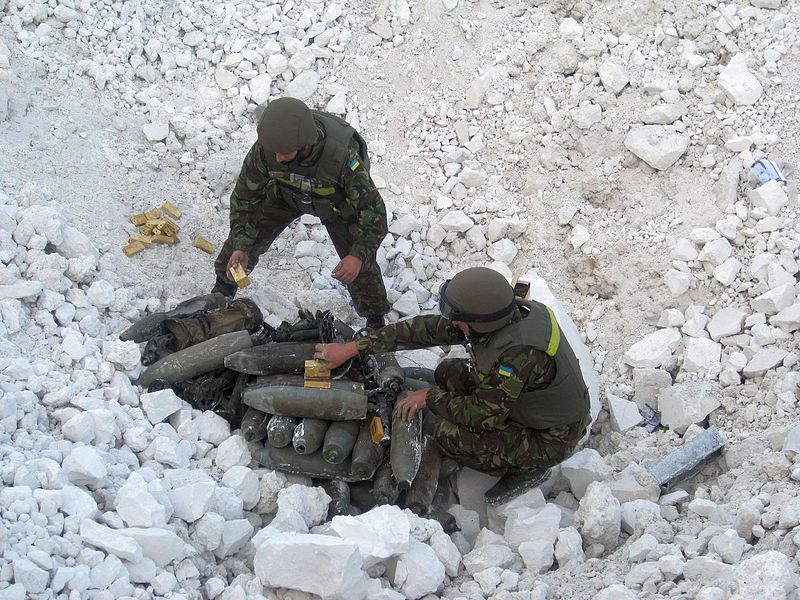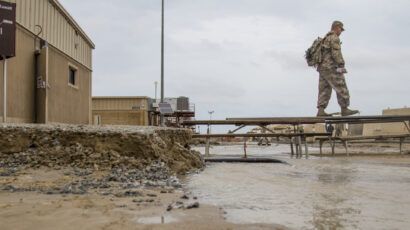War-related environmental disaster in Ukraine
By Kristina Hook, Richard “Drew” Marcantonio | October 16, 2018
 Ordnance gathered in what the Ukraine government called an anti-terrorist operation in Eastern Ukraine.
Ordnance gathered in what the Ukraine government called an anti-terrorist operation in Eastern Ukraine.
Yevhen Yakovlev sat in his Kiev office, some 700 kilometers from Ukraine’s still-hot war with Russian-backed separatists, the room overcrowded by piles of paper containing primary data about the conflict. “Ukraine is standing before, first of all, an ecological catastrophe,” he said, “more deep and dangerous than Chernobyl.”
A geologist and now chief researcher at Kiev’s Institute of Telecommunications and Global Information Space, Yakovlev has earned the right to reference Chernobyl, the 1986 nuclear accident in then-Soviet Ukraine that continues to haunt the country’s physical, geological, and political landscape. In May 1986, one month before that nuclear disaster, Yakovlev was set to receive a reprimand from the Communist authorities in Moscow, who had reacted negatively to his reports of troubling irregularities at Chernobyl’s ill-fated Reactor No. 4. Later, as a member of the Chernobyl response brigades, Yakovlev would be decorated for his role in the clean-up efforts.
Now, a review of Yakovlev’s data and other environmental information regarding the active conflict in Ukraine has convinced us that the current war in the eastern portion of that country has heightened the potential for a severe ecological disaster there.
Now in its fifth year, the war in eastern Ukraine shows no indication of approaching a conclusion. At least 11,000 people are confirmed dead, and nearly two million internally displaced persons have been registered by Ukrainian authorities, with informal estimates in both categories running significantly higher. Among the less-reported features of the conflict are some of the highest landmine-related casualty rates in the world. And one enormous problem—significant environmental damage that includes the particularly dangerous flooding of a series of inter-connected mines that stretch across the contact line between Ukrainian and Russian-backed forces, posing the possibility of massive poisoning of water supplies and spreading of radioactive contamination—threatens to cause an ecological collapse. Such a collapse could create a legacy of human devastation lasting well beyond the still-unforeseen end of active warfare.
The lack of international attention given to this environmental crisis can be attributed in part, to the status of the Ukraine conflict as a “forgotten war.” The war itself, of course, warrants increased international attention. But because of its enormous scope, the potential for long-term environmental disaster in eastern Ukraine also deserves a focused global response.
The big picture—environmental damage and conflict. Ukraine’s present reality perfectly illustrates the danger of a negative feedback loop between warfare impacts and environmental legacies. The degradation of the environment caused by war and its constituent activities comes in many forms: air pollution from the building of and the follow-on emissions from military vehicles; trash and surface waste that remains uncollected, promoting disease and the contamination of water resources; soil and water pollution caused by toxic unexploded ordnance and detonated munitions; and particulates and other air pollutants emitted from destroyed and smoldering buildings.
In wartime, the environment often becomes degraded because normal maintenance is neglected or limited. War may prevent local and national environmental managers from conducting their regulatory duties, in part by making it impossible for them to move about freely. The government may reduce funding for environmental services, shifting money to the war effort or to other areas deemed more essential during times of conflict, such as health and food services. Contaminated sites that require active management may be abandoned or, at least, management efforts will be significantly reduced.
In eastern Ukraine, persistent pollution sources include abandoned mines in this heavily industrialized region, livestock production facilities, and agricultural runoff. The war has increased the risks present at these sites while decreasing the Ukrainian government’s capacity to deal with them.
A history of environmental impacts in eastern Ukraine The eastern Ukrainian region that serves as the primary theatre of war includes the Luhansk and Donetsk oblasts (“provinces”). Taken together, these two provinces are often referred to as the “Donbas,” a nearly 200-year-old term that hints at the environmental issues now facing Ukraine. The word Donbas is a shortened version of Donetsky Bassein (literally, “Donets coal basin”) and is believed to have been first introduced by the mining engineer Yevgraf Kovalevskyi in the 1820s to signify the rich coal deposits found in the Siverskyi Donets river basin. This coal basin is some 500 kilometers across, stretching from the Dnipro to the Don River in modern-day Ukraine and Russia, respectively. Estimates put the total area of the coal basin at 60,000 square kilometers. As a comparative reference point, the Ruhr coal basin in Germany is one-13th that size. The Donbas region also includes major population centers across four Ukrainian provinces (the Luhansk, Donetsk, Kharkiv, and Dnipropetrovsk oblasts), as well as one Russian province (the Rostov oblast).
The Donbas area is highly industrialized and includes a dense sprawl of active industrial production facilities and inactive sites. The conflict in eastern Ukraine is happening in and around these industrial complexes, exposing them to damage that not only reduces production but increases potential environmental risks. Donbas is home to one of the world’s largest coal mining regions; before the current conflict, Donbas coal was one of the main sources of energy for all of Ukraine. In fact, 90 percent of Ukrainian coal comes from the Donetsk oblast, and the Donbas area contains 900 active and inactive mines. (This figure includes both surface and subsurface mining operations.) It is estimated that, in total, 15 billion metric tons of coal and nine billion metric tons of rock have been extracted from the ground in the Donbas, and that nine billion cubic meters of subsurface shafts and tunnels have been constructed.
Surface mines are often associated with environmental harm; they are, after all, directly exposed to the erosive and transporting power of rain and wind. The mines in the Donbas area, however, are both deep—averaging 720 meters in depth, and reaching as deep as 1,380 meters—and close to surface waters. As a result, they are exposed to groundwater flows that can percolate into mine shafts; to mitigate the associated risks of this flooding requires that water be pumped from the mines on a regular basis. The subsurface of the Donbas region is also rich in methane gas, which makes mining significantly more risky and increases the environmental impacts of subsurface mining. Between 1991 and 2000, 3,459 miners died in subsurface explosions due to the ignition of methane. Mines are estimated to release up to six billion cubic meters of methane a year.
Accumulating environmental risks now accelerating. The long history of mining and industrial production in the Donbas region has resulted in the accumulation of environmentally risky sites that contain pollutants, ranging from heavy metal toxins in mining tailings to industrial chemical pollution around manufacturing buildings. Before the current war, the Ministry of Ecology and Natural Resources (MENR) designated 4,240 sites as potentially hazardous. Specifically, 2,160 sites are deemed potentially explosive due to methane content, 24 are flagged due to radiation hazards, 909 are hydro-dynamically hazardous, and 34 are biohazardous. Before armed conflict began, the MENR actively monitored and managed each of these sites to mitigate the environmental and health risks.
Clearly the resources of the Donbas, particularly its coal deposits, are critical both to the Ukrainian state and the Russian-backed separatists operating in the non-government controlled areas. In 2017, the Ukrainian government issued an order to embargo the purchase of coal extracted in the Donbas, even though the coal is much needed in government-controlled Ukraine. The government decided to explore alternative energy sources rather than buy Donbas coal —and potentially fund Russian-backed separatist operations there. Partially in response to this, evidence suggests that Donbas coal is being exported, primarily through Russia, providing funding to rebel forces. The resources of the Donbas are not the direct causal mechanism of the conflict, but they are integral to it, providing revenue for the militant forces and providing an incentive for the Ukrainian government to regain access to them.
Ukraine suffered severe economic problems after it gained independence in 1991, with its economy contracting between 9.7 to 22.7 percent each year for the ensuing five years, with economic growth not recommencing until 2000. It also experienced extraordinarily high production declines and hyperinflation. Until the Soviet Union dissolved, and Ukraine gained independence, Soviet industry had been the primary consumer of Donbas coal. During the rocky transition from the planned Soviet economy to a market system, the upkeep of factories and mines declined, and the Donetsk and Luhansk oblasts hit the bottom of Ukrainian provinces in terms of human development.
But coal production—including coking coal for steel production—continued, and Donbas business owners grew into some of Ukraine’s richest citizens. They funneled part of their profits into politics, and they helped found the Party of Regions, a pro-Russia political party of Ukraine.
Since 2014, when the conflict over control of the Donbas began, war activities have caused a variety of forms of environmental degradation. One involves the proliferation of unexploded ordnance and the emplacement of landmines. Unexploded or partially exploded ordnance remnants can leach toxic chemicals into the soil and underlying water table, and undetonated explosives can prevent environmental authorities from doing their jobs. Similarly, landmines can restrict use of an area even as they degrade, leaking toxic chemicals.
In the short term, the environmental risk is direct harm to human lives and health, as demonstrated by extraordinary civilian casualty rates from landmines and unexploded ordnance; about 50 people are killed and wounded each month. The long-term concern is the effect on soil, ground and surface water, and land use.
The conflict also directly degrades the environment through the destruction of infrastructure by artillery and other munitions. This destruction releases hazardous air pollutants that have short- and long-term health effects. Attacks on infrastructure have also disabled trash removal and water supply and wastewater treatment systems; household and industrial wastewater in the Donbas now often goes untreated into surface waters because treatment facilities have been destroyed or pumping and treatment stations are no longer being manned. Combined with the suspension of most household trash services, this collapse of wastewater treatment has led to significantly increased surface water contamination of the Donetsk River and other water sources. These sources demonstrate levels of fecal coliform 10 times the governmental standard, which these same test sites met before the war.
In the mines: Warning signs of nuclear and other contamination. The fighting in the Donbas has made it next to impossible for the MENR and other government ministries to effectively do their jobs in the Luhansk and Donetsk oblasts. One of the primary pre-war roles of the MENR was to monitor, regulate, and manage the environmental impacts of the 900-plus active and inactive mines (mostly coal mines) throughout the Donbas, approximately 200 of which are at risk of flooding due to groundwater aquifers and flows. Before the conflict began in 2013, the MENR oversaw the pumping of some 2.2 billion liters of groundwater per day to keep mine shafts from flooding. A flooded mine shaft can dissolve pollutants—ranging from minerals that increase the salinity and hardness of water to toxic heavy metals such as mercury, lead, and arsenic—and introduce them at significantly increased rates into surrounding ground and surface water.
In the Donbas context, the concern about contamination is amplified because several mining operations used nuclear detonations during the coal-extraction process; this occurred, for example, at the Kilvazh facility in the Yunkom mine in the Donetsk oblast. These sites now pose a risk of radioactive contamination if irradiated debris is carried out of the shaft in mine water. The most recent survey by the MENR—conducted in 2016—found 35 mines where groundwater pumping had stopped and the mines were therefore flooded. The survey also found that groundwater pumping in total had decreased from 2.2 billion liters per day to 1.4 billion liters per day, and MENR officials believe this amount has continued to significantly decrease as conflict prevents managers from reaching the mines.
The interaction of these factors—deterioration of mine management and pumping, flooding of subsurface mines, and surface water contamination by groundwater—has reduced water quality throughout the Donbas. In 2016, the MENR tested 35 wells, springs, and surface water sources in the government-controlled areas of the Donbas and 26 wells, springs, and surface waters in the areas the government does not control. Before the war, the MENR found that these sites all provided potable water; the results of the 2016 survey demonstrated that 30 of the 35 government-controlled sites and 25 of 26 of the other sites were contaminated above MENR water quality standards and deemed non-potable.
Three of the sites—located in the villages of Beretski, Krasne, and Mariupol ,which are near inactive mines where subsurface nuclear detonations had been used—had radiation levels that significantly exceeded the baseline in the Donbas of 15 microrems per hour (mcR/h); the villages showed levels of radiation at 154 mcR/h, 152 mcR/h and 103 mcR/h respectively. (For comparison, the United States Environmental Protection Agency suggests that multi-year exposure levels should not exceed 11.4 mcR/h.) The MENR asserts that the increased rate of contamination is caused when water enters inactive and unmanaged mines, where it becomes contaminated and then moves to surface waters through springs, flooding, and percolation into groundwater. The ministry estimates that 87,000 cubic meters of contaminated mine water is discharged every hour.
The flooding of mines in the Donbas has produced environmental hazards beyond water contamination. The MENR estimates that the rate of methane and radon released from subsurface mines has likely substantially increased because of mine flooding, decreasing air quality in the vicinity of the mines. The ministry has not, however, been able to access mine sites to confirm this suspicion. Also, mine flooding has destabilized 9 billion cubic meters of horizontal tunnels throughout the Donbas, causing some 8,000 square kilometers of land above the mines to experience an average of 1.75 meters of subsidence.
So the impacts of environmental neglect due to warfare in the Donbas are expressed in both geophysical processes—such as subsidence and groundwater contamination—and physiological processes, including the slow degradation of human and environmental health due to increased pollution. Some of these impacts are immediate, for example respiratory distress or enteric disease; other impacts show up in the long term, often in the form of cancer.
The daunting legacy of ecological collapse. With much of the Donbas environment degraded and made unsafe by contamination and unexploded ordnance, control over resources that are functioning and useable is rendered even more valuable and important. Two resources in short supply and high demand because of the war are water and fuel—primarily in the form of coal. Many municipal water facilities have either been destroyed or are non-functional due to lack of maintenance, forcing people to seek alternative water sources such as boreholes, wells and springs. As access to clean water continues to diminish, the import of water will become necessary, resulting in a new potential mechanism of control over the population.
As previously discussed, Donbas coal is being quietly exported out of the country to fund the Russian-backed separatists’ operations in the region. The sale of coal allows these Russian-backed forces to purchase needed supplies and be less reliant on the surrounding population—which also allows them to exert control over the Donbas population more fully than might otherwise be the case. By controlling the extraction and flow of coal, the Russian-backed forces also control its distribution to local populations who need it for cooking and heating.
Use of this mechanism of control is likely to increase in the Donbas as the conflict continues and resources become scarcer. In the areas not controlled by the government, the MENR and other state ministries cannot provide essential services. The physical and psychological impacts of this failure to deliver basic services will likely continue to accumulate and to negatively affect the population. As this spiral continues, it will augment the influence of those actors who do control the scarce resources that persist.
This complex picture of the environmental emergency in Ukraine suggests that the cost of war stretches well beyond the confines of direct physical fighting. Unless this array of environmental issues is directly addressed, the ecosystem and the people inhabiting the Donbas region will suffer and literally embody—for example by drinking contaminated water and pollutants like lead and mercury, which will concentrate in the body—the damage for decades to come.
It is in the interest of the Ukrainian government, the Russian-backed separatists, and the Russian government to begin to confront the strategic implications of this environmental disaster, which is likely to spread across the Ukrainian-Russian national boundary. Regardless of any short-term, tactical advantage it may confer on the Russian-backed forces, the ecological collapse of the Donbas is in the interest of neither side in this conflict—even as it rapidly becomes a disastrous reality.
When pressed for comment on what might happen without a rapid mobilization of political will by the warring parties and global technical assistance, Yakovlev, the eminent geologist, quietly concluded, “Donbas can destroy Ukraine.”
Acknowledgements. The data collected and analyzed for this article primarily came from scientists working with the Ukrainian Ministry of Ecology and Natural Resources (MENR), from reports and studies authored and published by the MENR, and from interviews conducted with academic experts, government officials, journalists, and other individuals connected to the ongoing environmental disaster in the Donbas. The authors express their thanks to George A. Lopez of the Kroc Institute at the University of Notre Dame for his editorial assistance. The authors also express appreciation to geologist Yevhen Yakovlev for his research contributions and generous data-sharing as well as to Nataliya Gumenyuk and her media team at Hromadske International for their original investigative reporting on environmental issues in Ukraine. This article also greatly benefitted from research and translational assistance from Oksana Yanchuk. The authors thank the Joan B. Kroc Institute for International Peace Studies and the Anthropology Department of the University of Notre Dame for their continued research support.
Kristina Hook acknowledges funding by the National Science Foundation’s Graduate Research Fellowship Program (NSF-GRFP), a USAID/ Notre Dame Global Development Fellowship, a Nanovic Institute for European Studies of the University of Notre Dame grant, and a US Student Fulbright Fellowship.
Together, we make the world safer.
The Bulletin elevates expert voices above the noise. But as an independent nonprofit organization, our operations depend on the support of readers like you. Help us continue to deliver quality journalism that holds leaders accountable. Your support of our work at any level is important. In return, we promise our coverage will be understandable, influential, vigilant, solution-oriented, and fair-minded. Together we can make a difference.
Keywords: Donbas, Ukraine, ecological collapse, radioactive contamination
Topics: Analysis, Investigative Reporting, Nuclear Risk, Special Topics, Voices of Tomorrow
















